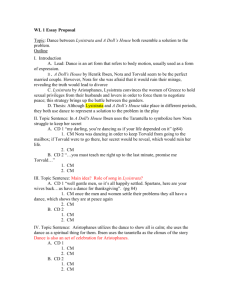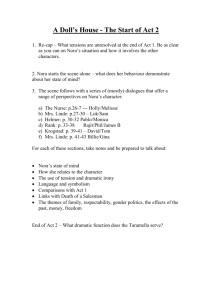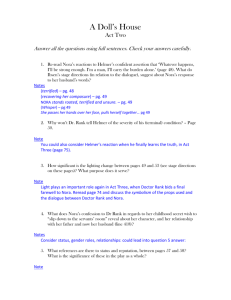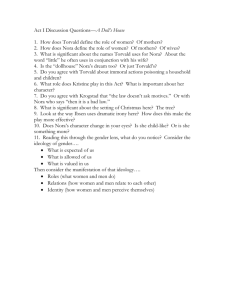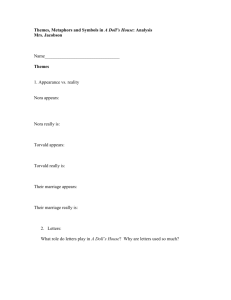TaniaVidalEssayComments
advertisement
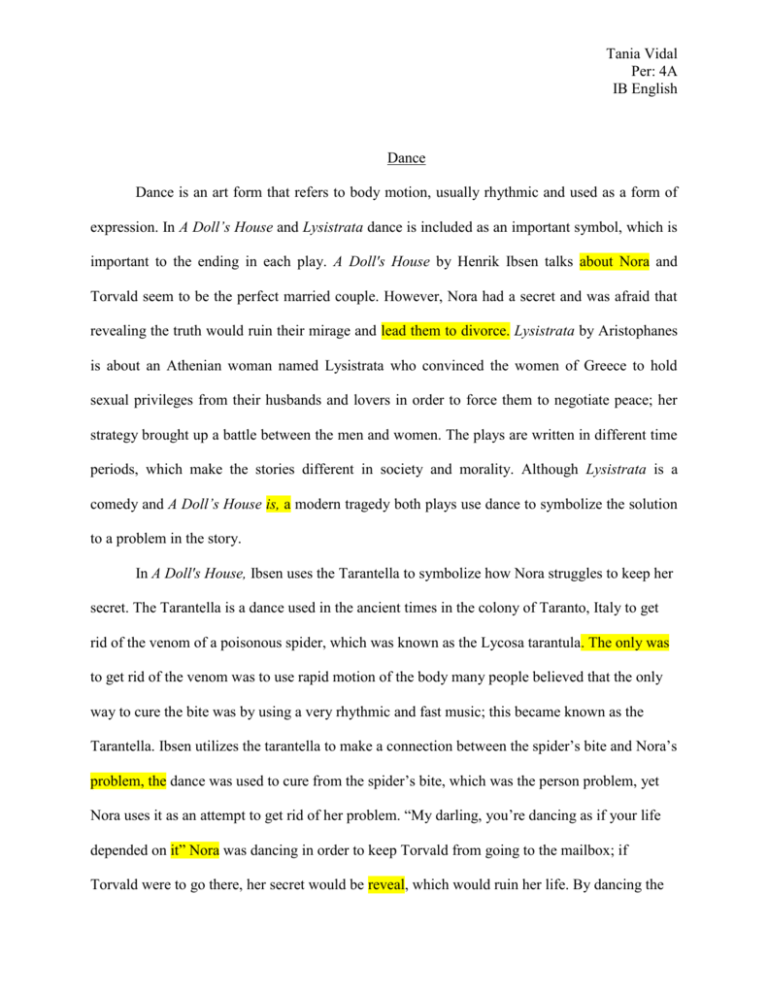
Tania Vidal Per: 4A IB English Dance Dance is an art form that refers to body motion, usually rhythmic and used as a form of expression. In A Doll’s House and Lysistrata dance is included as an important symbol, which is important to the ending in each play. A Doll's House by Henrik Ibsen talks about Nora and Torvald seem to be the perfect married couple. However, Nora had a secret and was afraid that revealing the truth would ruin their mirage and lead them to divorce. Lysistrata by Aristophanes is about an Athenian woman named Lysistrata who convinced the women of Greece to hold sexual privileges from their husbands and lovers in order to force them to negotiate peace; her strategy brought up a battle between the men and women. The plays are written in different time periods, which make the stories different in society and morality. Although Lysistrata is a comedy and A Doll’s House is, a modern tragedy both plays use dance to symbolize the solution to a problem in the story. In A Doll's House, Ibsen uses the Tarantella to symbolize how Nora struggles to keep her secret. The Tarantella is a dance used in the ancient times in the colony of Taranto, Italy to get rid of the venom of a poisonous spider, which was known as the Lycosa tarantula. The only was to get rid of the venom was to use rapid motion of the body many people believed that the only way to cure the bite was by using a very rhythmic and fast music; this became known as the Tarantella. Ibsen utilizes the tarantella to make a connection between the spider’s bite and Nora’s problem, the dance was used to cure from the spider’s bite, which was the person problem, yet Nora uses it as an attempt to get rid of her problem. “My darling, you’re dancing as if your life depended on it” Nora was dancing in order to keep Torvald from going to the mailbox; if Torvald were to go there, her secret would be reveal, which would ruin her life. By dancing the Tania Vidal Per: 4A IB English Tarantella incorrectly, Nora was able to keep her mirage life alive, and perfect, or at least seem to be perfect. “…you must teach me right up to the last minute, promise me Torvald…you mustn’t open a single letter, not even go near the mailbox.” Ibsen uses this sentence as Nora’s attempts to give herself time to come up with a plan to stop Krogstad from revealing the truth to Torvald, by asking Torvald not to go to the mailbox until the next day. She thought she would be able to come up with a solution or a plan to save her mirage with the help of Mrs. Linde. Ibsen usage of the sentence adds an importance to the way he uses the dance by showing how it important it was for Nora to dance the tarantella incorrectly, although she already knew how to dance it. In Lysistrata, Aristophanes uses dance in the last act to symbolize the peace that was finally settled between the genders after they uses Lysistrata’s strategy. “Well gentle men, so it’s all happily settled. Spartans, here are your wives back. And here are yours. …and let us have a dance for thanksgiving-”. After the women held their sex privileges from the men, they all stopped their war and agreed to make an agreement with the women. After the agreement was made Lysistrata let the women go back to their husbands and asked them to start a dance of thanksgiving. The author then includes a dance in which the men and women pair up, by dancing they all give thanks to the god for giving the a solution. “And let us for the future all endeavor, Not to repeat our errors, never ever!” Aristophanes uses this as one of the few last words that Lysistrata says in the play, by doing this it makes the words have and important role in the story. Aristophanes uses the sentence to show that by using Lysistrata’s strategy the women succeeded and would not be using it against the men again, as long as the men would not commit the error of going into war and leaving their wives at home to clean and stay all day, as they had done before Lysistrata’s plan had been created. Tania Vidal Per: 4A IB English In A Doll’s House, Nora uses the dance to stall Torvald from finding out the truth, while in Lysistrata, the men and women dance with each other to symbolize that the problem is solved. Aristophanes utilizes the dance to show all is calm, it is used as an act of celebration for them the restoring of peace within each other. “come, let us on the graces call Apollo…that Aphrodite made, The goddess who Is love” The song used for the dance represent a prayer that the people use to thank the gods, for the restore the tranquility, the author also uses the song and dance as a spiritual thing for them. Ibsen uses the Tarantella as the climax in the story, he uses it to help Nora look for a solution, although Nora got a solution that was not the one she wanted it, using the Tarantella gave her time to find a solution to her problem. The Tarantella is an important part the play, the dance was used to get rid of spiders poison for many years but people started faking spider bites after a few years in order to dance the Tarantella, like in the play the dance was used to get rid of a problem, but later became something else. Finding a solution to the situation of each play was crucial to the characters of each play; by using dance, the authors were able to facilitate the solution. They use of dance was a way for the authors to portray the peacefulness the solution brought to each play. Although Lysistrata was a comedy and A Doll’s House was a tragedy, both problems were resolved. The way they resolved the problem in the plays were different in each play, it shows that there are many ways to find a solution to a problem, but the solution will not always be what one wants. Tania Vidal Per: 4A IB English Name ________________________________________________________ Period ____ Comments: (An X indicates _____ (20) Word Choice ___ Lively Verbs need for improvement.) _X__ Expanded Vocabulary ___ Academic Voice ___ Avoids Cliché ___ Absence of Redundancy __X_ Precise Words/Phrases __affect/effect __real/really __its/it’s __fewer/less __further/farther __have/of __if/whether __use/used __that/which/who __imply/infer __accept/except __a lot __can/may __good/well __lose/loose __than/then __their/they’re/there __to/too/two __whose/who __your/you’re _____ (20) Organization ___ Indented Paragraphs ___ Hook ___ Intro author/title/brief summary _X__ Focus _X__ Coherence ___ Balance ___ Unity (Strong Closer) _____ (20) Sentence Fluency _X__ Sentence Combining ___ Sentence Variety/Openers ___ Parallel Structure ___ Transitions _X__ No run-ons/fragments _X__ Agreement -- Tense, S/V _____ (20) Idea Development ___ Evidence of Prewriting ___ Clear, effective thesis ___ Sufficient supporting details/evidence _X__ Demonstrates critical thinking skills ___ Length _____ (20) Process and Presentation ___ Evidence of Revision ___ Format ___ Correctness/Conventions __colons _X_commas __quotations __semicolons __apostrophes __capitalization __citations _X_end marks I think you could do more with P4 where you directly compare the two. For example, how do the dances affect the atmosphere of their respective scenes? How are the atmospheres different? I’m not sure about your assertions regarding Nora dancing the tarantella incorrectly. Revisit your analysis and be more specific about what the tarantella symbolizes. Tania Vidal Per: 4A IB English
